[ad_1]
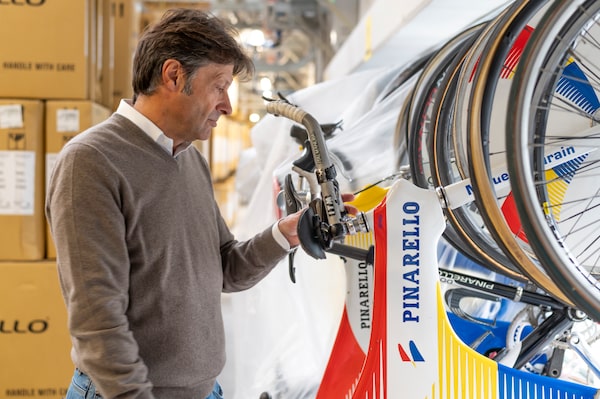
Fausto Pinarello with historic bikes in the Pinarello’s archive area, on Nov. 14, in Treviso, Italy.Fabrizio Troccoli/The Globe and Mail
The story of Italian racing-bike maker Pinarello began with defeat and humiliation for the company’s founder.
In 1951, Giovanni Pinarello placed dead last in the Giro d’Italia, one-third of the Grand Tour races that include the Tour de France and the Vuelta of Spain, earning him the dreaded maglia nera, or black jersey. Realizing that the young man had no future in the pedalling game, his team bought out his contract for 100,000 liras, then the equivalent of a couple of hundred bucks – a small fortune. Giovanni used the money to open a cycling shop in his hometown of Treviso, just north of Venice, and was soon making bikes bearing his name.
He had far more success as a builder than as a racer, and lived long enough – he died in 2014 – to see Cicli Pinarello become one of the top performance-bike brands, a pocket-sized global company whose highly expensive carbon-fibre machines – the top-end Dogma series starts at €15,000 ($22,000) – are coveted by professional racers and wealthy amateur bikers everywhere. He did not live long enough to see the transaction that may take Pinarello to the next level on the global stage.
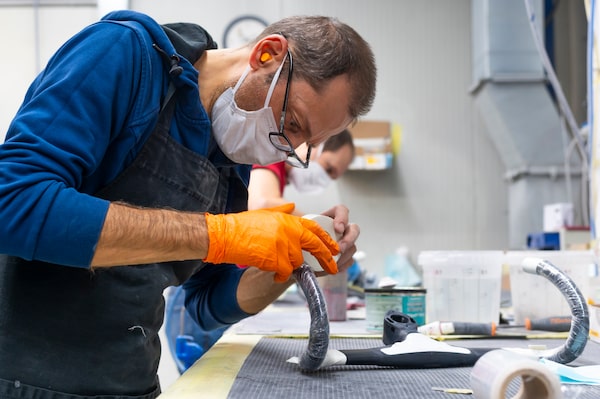
A Pinarello technician works on a bike.Fabrizio Troccoli/The Globe and Mail
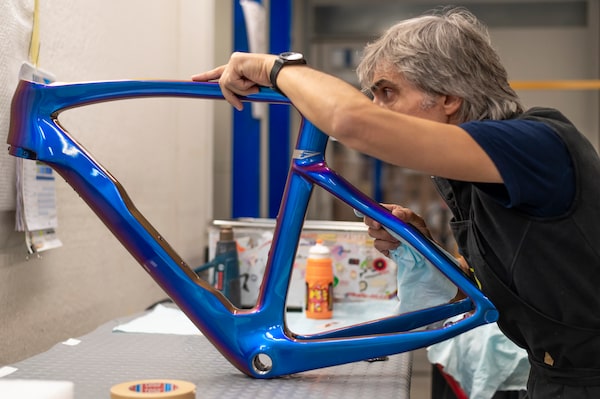
A decal department worker at Pinarello.Fabrizio Troccoli/The Globe and Mail
In June, Ivan Glasenberg, the Swiss-South African billionaire who is the former chief executive officer of Switzerland’s Glencore GLNCY, the mining giant that just agreed to buy 77 per cent of the coal business of Vancouver’s Teck Resources for US$6.9-billion, bought Pinarello for about US$175-million, measured by enterprise value (debt and equity). The seller was Connecticut private equity fund L. Catterton, which is backed by the French luxury group LVMH Moët Hennessy Louis Vuitton.
In an interview in Treviso earlier this month, Mr. Glasenberg said he bought Pinarello to fulfill his desire to create a luxury sporting goods group; the bike maker will be its anchor.
“No one has ever put luxury sports brands together successfully,” he told The Globe and Mail. “I will wait for opportunities to come.”
The Pinarello purchase has come at the right time for Mr. Glasenberg, who is 66, was born in Johannesburg and owns 10 per cent of Glencore. When he left the mining company in 2021, he did not want to indulge in idle retirement. Instead he pursued his love of sports – he is a former race-walking champion for South Africa and a devoted biker – by trying to make a splash in the sports gear business.
In the same year he left Glencore, he spotted a small Italian bike-clothing brand called Q36.5, fell in love with its products and bought a big stake. Along with co-founder and chief executive Luigi Bergamo, he made plans to transform it into a top 10 global bike-clothing company and racing force. Already, the Q36.5 team, which was launched early this year, is placing high on the pro circuit and hopes to get invited to the Vuelta and Giro d’Italia some time soon. Among its star riders is Quebec-born Nick Zukowsky, 25, who won the 2023 Canadian National Road Champion title.
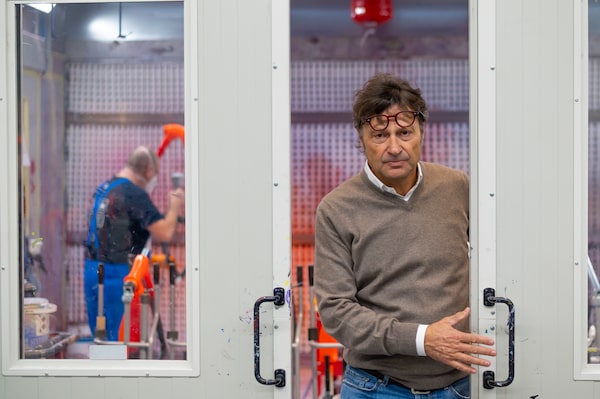
Fausto Pinarello, Chairman of Pinarello, in Treviso, Italy, on Nov. 14.Fabrizio Troccoli/The Globe and Mail
Amacx, a Dutch sports nutrition company, was a smaller purchase. Mr. Glasenberg also did a royalty deal that saw him finance SRM, a German tech company that makes electronic devices that measure the power, expressed in watts, delivered by a biker as he or she pedals.
About the same time that Mr. Glasenberg bought Q36.5, it became known in the biking world that Catterton, which had bought Pinarello in 2016 for a reported €90-million ($134-million) in equity value, was looking for an exit strategy. Fausto Pinarello, Giovanni’s son, never wanted to sell the company back then, but financial disputes within the Pinarello family triggered the sale. Mr. Pinarello acknowledges that he felt out of place during the Catterton era, when the top employees came under enormous pressure to sell, sell, sell to boost the revenues and profits for the inevitable cash-out down the road.
Mr. Pinarello remembers getting a call from Mr. Glasenberg about three years ago. “He said, ‘Do you want to sell the company’? I didn’t know who he was.”
Mr. Pinarello soon found he was dealing with a wealthy sports fanatic who would value his continued role in the company that bore the family name. When the deal was done, Mr. Pinarello retained his chairman’s title and an equity stake of about 10 per cent. What he likes most about the new ownership is that it allows him to return to his passion – developing fast, winning bikes. “I am richer now, but happier,” he said. “Ivan has an athlete’s mentality and I am returning to building super, high-end bikes.”
Today, he works the floor of the Pinarello factory in suburban Treviso all day long, visiting every department. The term “factory” is somewhat of a misnomer, since the ultralight bike frames – the most expensive ones weigh about 850 grams, or less than two pounds – are built in China and Vietnam, delivered to Taiwan for semi-finishing and exported to Italy, where they are sanded, polished, painted and fitted with all the components such as the drivetrains, disc brakes and wheels.
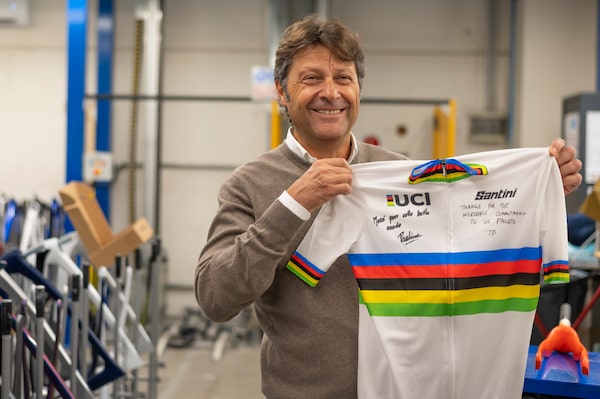
Fausto Pinarello with a signed jersey he received from Tom Pidcock and Pauline Ferrand Prevot, who both won a world title on Pinarello’s new mountain bikes in August.Fabrizio Troccoli/The Globe and Mail
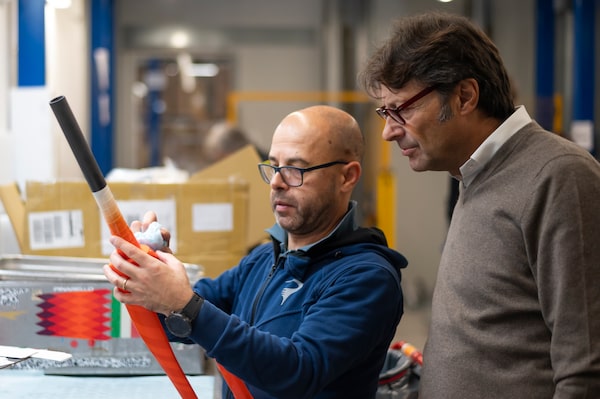
Fausto Pinarello checking some details in the decal section.Fabrizio Troccoli/The Globe and Mail
Buffing and painting each frame takes 200 to 300 minutes. One option, priced at €1,800 ($2,700), is a special paint that changes from blue to purple, among other colours, depending on the angle that the light hits the frame. The rest of the factory is devoted to R&D, testing, marketing, packaging and shipping.
Pinarello is not struggling for clients in spite of prices equivalent those of a small car. Revenue came to about €130-million ($193-million) in the last fiscal year, up 15 per cent from the previous one. The company expects a similar rise this year.
The marketing formula is based on Italian heritage and design and the flat-out racing pedigree of a marque that has won 15 Tour de France, eight Giro d’Italia and seven Vuelta. “You can only work here if you are deeply in love with sport,” said Federico Sbrissa, Pinarello’s chief marketing officer. “We can sell you the same bike that could win the Tour de France next year.”
Where will Pinarello go next? Mr. Pinarello thinks tech advances, as compelling as they were over the past decades with innovations such as carbon frames, electronic shifting, disc brakes and wind-tunnel testing to create sleek bike profiles, still have a long way to run. New materials and manufacturing methods are inevitable, he says. Already Pinarello is experimenting with 3-D printing in non-carbon materials that would allow custom-made frames and local production.
Mr. Glasenberg appears to have no intention of tampering with Pinarello’s Italian heritage, design and race-winning focus. “I love sport and I am doing this for pleasure,” he said.
[ad_2]
Source link
